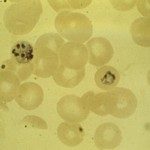Link to Pubmed [PMID] – 6091905
Cell 1984 Nov; 39(1): 129-40
Two loci have been characterized in the mouse Mus musculus, which are homologous to the mRNAs encoding myosin light chains MLC1F and MLC3F, two proteins with a common -COOH terminal sequence. One of these loci is an intronless pseudogene, absent from the mouse species Mus spretus; alterations in its nucleotide sequence preclude it from generating a functional MLC1F or MLC3F. The other contains the genetic information for the two proteins. The part common to both proteins is encoded by five exons, which cover about 6.5 kb. Genetic information specific for the N-terminal sequences is encoded in four exons, at 3.5 and 14.3 kb for MLC1F, and 3.8 and 4.5 kb for MLC3F, upstream of the first common exon. Each 5′ terminus has a TATA-like consensus sequence about 30 bases upstream of the cap site. The pseudogene is not genetically linked to the functional MLC1F/MLC3F locus in the genome of Mus musculus.

